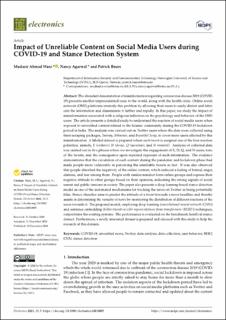| dc.description.abstract | The abundant dissemination of misinformation regarding coronavirus disease 2019 (COVID-19) presents another unprecedented issue to the world, along with the health crisis. Online social network (OSN) platforms intensify this problem by allowing their users to easily distort and fabricate the information and disseminate it farther and rapidly. In this paper, we study the impact of misinformation associated with a religious inflection on the psychology and behavior of the OSN users. The article presents a detailed study to understand the reaction of social media users when exposed to unverified content related to the Islamic community during the COVID-19 lockdown period in India. The analysis was carried out on Twitter users where the data were collected using three scraping packages, Tweepy, Selenium, and Beautiful Soup, to cover more users affected by this misinformation. A labeled dataset is prepared where each tweet is assigned one of the four reaction polarities, namely, E (endorse), D (deny), Q (question), and N (neutral). Analysis of collected data was carried out in five phases where we investigate the engagement of E, D, Q, and N users, tone of the tweets, and the consequence upon repeated exposure of such information. The evidence demonstrates that the circulation of such content during the pandemic and lockdown phase had made people more vulnerable in perceiving the unreliable tweets as fact. It was also observed that people absorbed the negativity of the online content, which induced a feeling of hatred, anger, distress, and fear among them. People with similar mindset form online groups and express their negative attitude to other groups based on their opinions, indicating the strong signals of social unrest and public tensions in society. The paper also presents a deep learning-based stance detection model as one of the automated mechanisms for tracking the news on Twitter as being potentially false. Stance classifier aims to predict the attitude of a tweet towards a news headline and thereby assists in determining the veracity of news by monitoring the distribution of different reactions of the users towards it. The proposed model, employing deep learning (convolutional neural network(CNN)) and sentence embedding (bidirectional encoder representations from transformers(BERT)) techniques, outperforms the existing systems. The performance is evaluated on the benchmark SemEval stance dataset. Furthermore, a newly annotated dataset is prepared and released with this study to help the research of this domain. | en_US |

